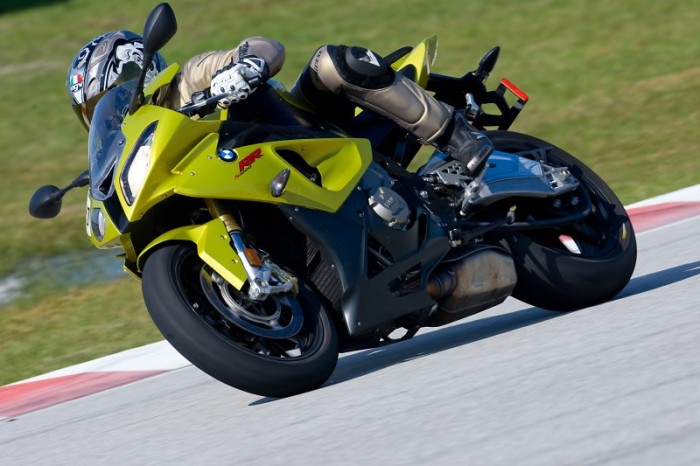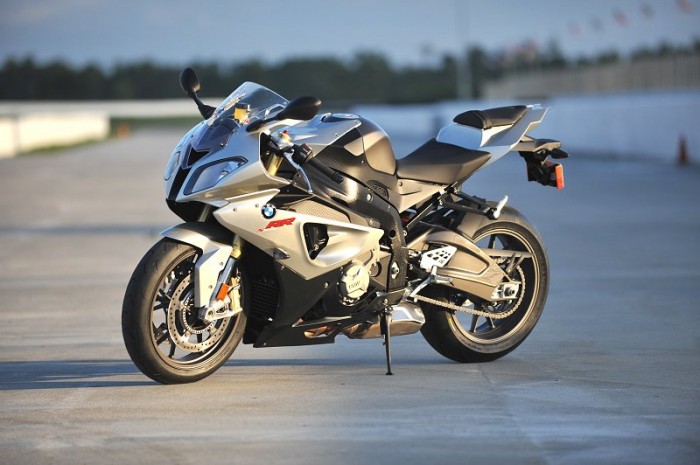Photos By Kevin Wing and Jon Beck
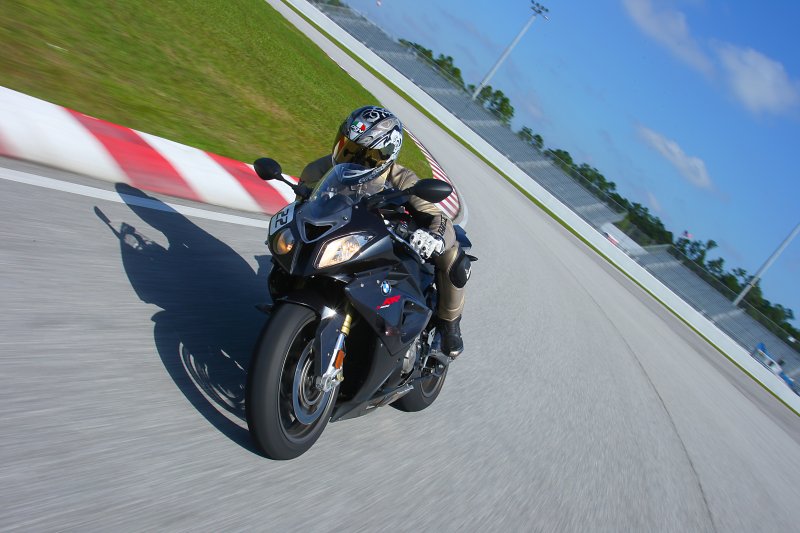
January, 1961: Inside a small metal capsule, 157 miles over the Atlantic Ocean, a young chimpanzee named Ham furiously pulls on a lever in response to the flashing light on the panel in front of him. He knows that if he doesn’t flip it fast enough, he will get a shock on the soles of his feet. After just a few minutes, what must be a pissed-off and confused monkey splashes down 400 miles from where he started in Cape Canaveral. One giant leap for ape-kind, which begs the question: why do we need John Glenn if a trained monkey can do his job?
February, 2010: On top of a small German-built motorcycle, six feet over the Atlantic Ocean, a middle-aged moto-journalist furiously clicks up on the gearchange lever in response to a flashing light on the panel in front of him. He knows that if he doesn’t upshift fast enough, he won’t catch the other journalists already blasting down the straightaway and he will be punished by being at the bottom of the event’s “fast guy” pecking order. At the end of the day, he has ridden harder and faster than he has in recent memory, and it begs the question: why do we need to learn how to ride like a pro if a little black box can do the job for us?
Yes, the 2010 BMW S1000RR really is that good. It’s not just faster than its Japanese counterparts, it’s also competitive on weight and price (more about this later), nicely developed and styled, and the optional electronics it offers are as groundbreaking and important to the average sportbike-riding Joe as the big advances in power/weight ratio represented by landmark bikes like the 1993 Honda CBR900RR, 1998 Yamaha YZF-R1 and 2001 GSX-R1000. But that’s only half the story: this bike is a BMW, not a company known for building cutting-edge hypersports motorcycles, at least not since cork was the material of choice for helmet liners. What the hell?
To understand that, you’d have to be a fly on the wall in the fancy conference room at the garishly elegant Four Seasons resort in West Palm Beach the night before the track day. There, BMW Motorrad North America V.P. Pieter De Waal sat down on an S1000RR-a bike he fostered when in command of BMW Motorrad’s global sales and marketing-and explained why his company would want to build such a thing.
The explanation, to any sportbike junkie, is just stating the obvious. BMW has always been known as a builder of comfortable, quirky and very pricey motorcycles for the more…genteel rider. The company does okay, but that’s not exactly a recipe for long-term survival of a brand. Six years ago, BMW was selling about 100,000 motorcycles a year, but De Waal says “we were worried for our future,” because of an “aging customer profile.” The average buyer’s age was 47 years old, surprisingly young compared to other companies, but that age was increasing about .7 years annually. These were loyal customers, but new ones were not coming in. At the same time, the Yen and other currencies were getting clobbered by the Euro, creating export disadvantages for european products … so drastic solutions were to be sought.
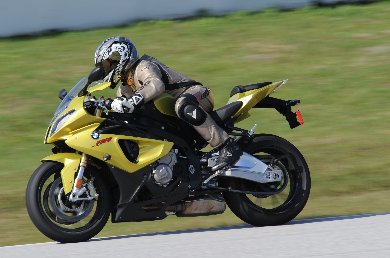
Since BMWs aren’t cruisers or superbikes-which represent the vast majority of motorcycles sold in the USA-just being in the 1000cc superbike category would offer BMW a potential 1/3-larger market than before, with much younger customers: the average 1000cc sportbike buyer is a cherubic 34 years old. “By bringing in sportbikes, it will make the brand relevant to a whole new customer,” explained De Waal. “It’s what people not in motorcycling expect from BMW as a brand. You’d never say our cars aren’t fast or can’t go around corners.” Not just adequate performance, as the twin-cylinder Beemers possess, or big performance in a big heavy package, like the K1300 series, but maximum power combined with minimum weight. “We have to play by the rules, and the rules were made by the four Japanese manufacturers.” Those rules are simple: race-winning performance, uncompromisingly sporty styling and competitive pricing.
And that was the design brief delivered to BMW’s designers and engineers. “You will build us a motorcycle that is the easiest to ride fast,” De Waal recounted telling the designers six years ago. “You will be faster on this motorcycle around the racetrack than any other motorcycle.” Was there wailing and gnashing of teeth, rending of garments and tortured cries of anguish as bureaucratic BMW engineers, used to building relatively overweight tourers, hurled themselves out of BMW’s glittering office building? Not quite, said De Waal. Not only do the windows not open, making auto-defenestration impossible, most of the engineers and designers are serious sportbike enthusiasts and were thrilled to have a clean sheet to work from. Absolutely no baggage to tie them to any particular design.
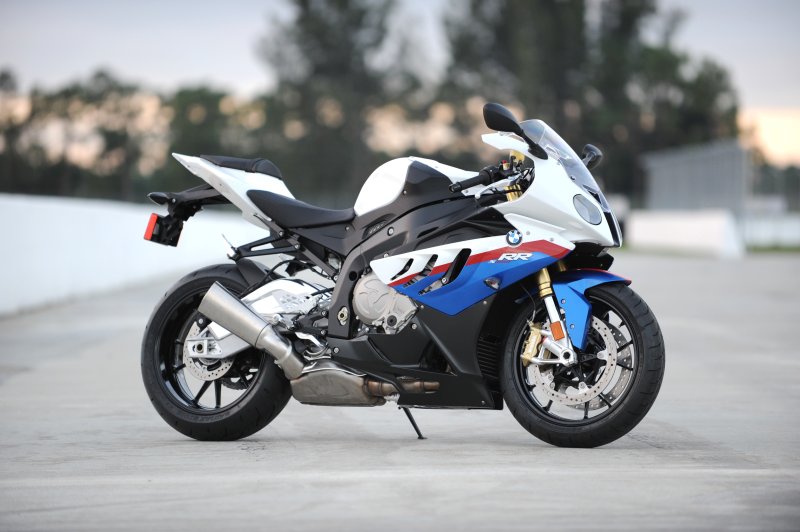
The result is the bike you’ve doubtless read about at length, but here is a tech brief, just the same. The motor is pure Japan, inc., at least at first glance: a liquid-cooled, dohc inline Four with 13.0:1 compression, four valves per cylinder, yadda, yadda. You’ve heard it since about 1986 or so. But God is in the details: the bore/stroke ratio is very short at 0.621, there are no shim buckets (instead there is some kind of aluminum and fiber material to set valve clearance), and the cam followers are tiny little things. It all points to very high rpm: the production bike’s 14,200 rpm redline is far short of its design potential. That’s probably why the bike comfortably dusts its competitors on the dyno, making 15 more hp than the next-most-powerful literbike. Actual power may be over 200 hp at speed, thanks to ram air.
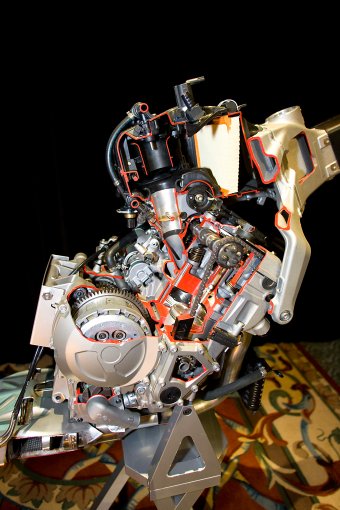
But the real news is the electronics. The standard bike has four rider-selectable tuning maps, but the optional Dynamic Traction Control/Race Anti-lock Brake package (DTC-ABS) is what sets the bike apart. The DTC utilizes the ABS sensors to detect wheelspin as well as lean-angle sensors to reduce power to the rear wheel when the situation demands. The intrusiveness of the ABS is also adjusted depending on mode. BMW admits it’s unable “to re-define, let alone change, the limits and laws of riding physics,” but the system can help a rider get closer to the ragged edges of those laws.
The chassis and styling looks Japan, Inc., but still has some unique touches. The frame is a light, sturdy truss, the swingarm is extra-long for maximum traction, and the tank is lightweight aluminum. The Sachs suspension is easily adjustable for rebound and compression damping using the tip of the specially designed ignition key, and the asymmetrical styling sets the bike apart. The reason for the squinty-looking headlight? The high beam doesn’t need a large reflector, so it can be smaller than the low beam, which means less plastic, and less weight: every gram counts, right? The “gills” on the left side aid cooling, and the simple, stubby muffler completes the SBK racer-for-the-street look. The cockpit is marked by clear, complete instrumentation and sensible, standard switchgear, complete with an easy-to-use laptimer.
Let’s talk price: a sportbike should be light, fast, and relatively cheap (for those young buyers), and although the S1000RR’s $13,800 MSRP isn’t cheap, it’s well inside the range of the Japanese brands (the Honda is $13,399, the Kawi is $12,999, the Yamaha is $13,290 and if you could buy a 2010 Suzuki GSX-R1000, which you can’t because Suzuki is bringing in few streetbikes for 2010, it would be over $12,900). But that low price is mostly academic, as only about five percent of the 1500 or so RRs will be base models. Instead, they will generally be equipped with the DTC/Race ABS package ($1480). The Shift Assistant option adds another $450, and the Motorsports graphics is another $750. After riding the bike (read on), I can tell you that you want the bike with the DTC/ABS and Shift Assistant, so figure $15,730 or more.
How can they bring it to market so much cheaper than previous models? With so much cutting edge technology? I asked if the rumors about the bike (or substantial portions of it) being made in China were true. “Absolutely not true,” said Pieter De Waal, emphatically. “The bike’s made in Berlin from A to Zed.” Are some components made in China? De Waal responde by asking me if it was possible to buy anything without some part of it being made in China. So I’ll take that as a yes, but other BMW personnel emphasized this was not for large bits like the motor or chassis.
The next morning, we dragged our leathers, helmets and hung-over heads onto the bus for the 45-minute ride to the track. Palm Beach International Raceway (also known as Moroso Motorsports Park) is one of the smoothest and flattest road courses I’ve ever seen. It’s as if somebody ironed it. The 11 turns in two miles are easy to learn, with a nice mix of rights and lefts, and there’s a 3000-foot straightaway to test the power. And the humid, 70-degree weather was just right for getting the most out of the motor.
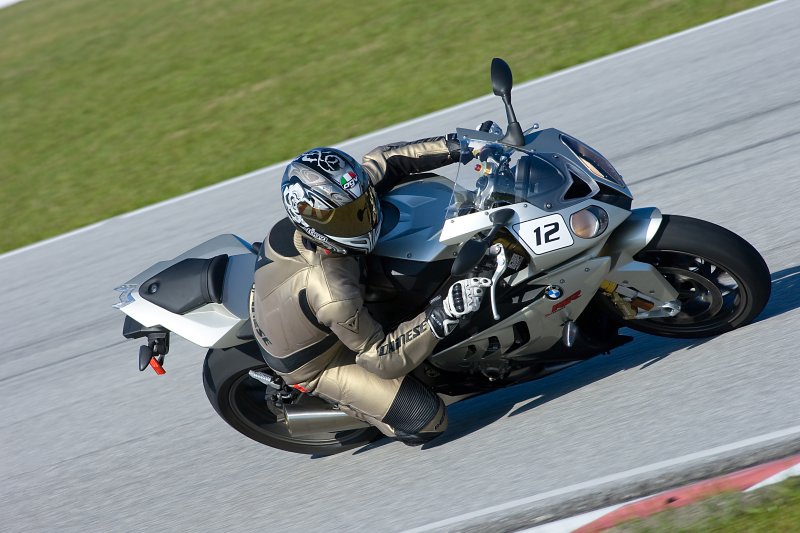
The first session was spent in Rain mode, limited to 150 horsepower, with power delivery retarded at a shallow lean angle. The bike felt mellow, docile, even, and at lower speeds-probably about what a sane street rider might consider pushing his luck on public roads-the steering felt easy, suspension was smooth and compliant, and the brakes were more than adequate. The second session was in Sport mode, with all 193 horsies unfettered, but with the DTC allowing more power at greater lean. And then, in a blissful third session, our racetrack guides told us to pick whatever setting we pleased. I opted for the full-on Race mode because…well, because I could. Slick mode, which allows for full power at elbow-dragging lean angles (as well as five-second power wheelies and limited ABS intrusion), is available only if you’ve inserted a special plug into the ECU: yes, the Germans have lawyers.
In Race mode, the DTC is almost transparent. In fact, I may never have felt it at all in Race mode, a contrast to the Rain or Sport modes, where I could feel it subtly adjusting power as lean angles altered. With my over-cautious middle-aged mind informed of the electronics’ nanny-ing, I found myself braking later and rolling on the throttle earlier. Soon I was getting major drive off the sharp right-handed corner before the 6/10th-mile straight and rocketing downrange. The optional shift assist and large, well-placed shift light made maximum acceleration easy: pin the throttle until the bright white glow appeared in the bottom-right corner of my field of vision, then ease up with my left toe-no throttle roll-off or clutchwork required. Luckily, BMW does not apply a mild electric shock to the soles of the rider’s feet if they do not follow instructions. Yet.
I know why Ham wore diapers: this motor makes power like a Redstone booster at maximum burn. By the time I was at the halfway mark down that straight, the big digital speedometer was reading 170 mph, probably optimistically, but still a higher number than I had ever seen on a racetrack. When it’s time to slow enough for the big sweeping hairpin at the end, the slipper clutch and speed shifter make shifting down three gears and dumping the clutch lever an undramatic event; no wheel hop or chatter. The brakes do an adequate job of smoothly and quickly hauling the bike down to a manageable speed and the rigid chassis and excellent geometry keep the front and back tires in line under hard braking. The gearbox seemed faultless, although I didn’t really need to use it much: the motor makes enough torque and/or top-end juice to pull the bike around in any gear you want: second, third, fourth, fifth, the spot-on fueling (although there was some abruptness off idle, like any fuel-injected ride) just smoothly added power whenever the throttle was twisted, tall gearing be damned.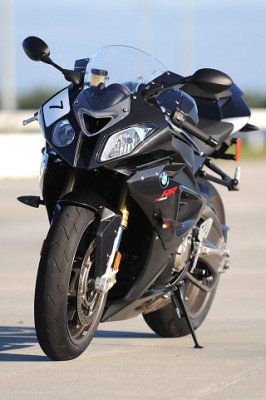
After a few sessions, I noticed the brake lever was coming halfway to the bar, sometimes even trapping my fingers if I was giving it a two-fingered squeeze. It was then that I realized this was probably normal for anti-lock brakes, easily remedied by adjusting the lever further out. Also, this fleet of bikes had been flogged the previous week by BMW dealers and Keith Code’s gang of instructors (Keith kept us company at the event, regaling us with stories of making platform shoes back in the ’70s: I asked him if he ever made a pair with goldfish swimming in water-filled Lucite heels. He didn’t seem to think that was a good idea at all). Still, the cast two-piece Brembos don’t have the wondrous bite and power of the higher-spec monobloc units: gotta save money somewhere, right? I don’t think anybody but a trackday junkie would mind. What’s remarkable is how unobtrusive the ABS is, and that it weighs just 5.5 pounds.
I wish I could tell you how the bike works on the street, but we were restricted to the track. I can guess, though: the seat is well padded and shaped to comfortably distribute weight, the pegs don’t feel overly high, and the bars feel right where they should be on supersport, right in line with the Japanese bikes. The mirrors are large and widely spaced and there’s an oil-sight glass for easy pre-ride checks. The suspension feels plush, but I’ll reserve judgment until I get on pavement with one.
While it doesn’t exactly ride itself, it sure doesn’t need the rider as much as motorcycles did in the past. Bulging with electronics and F-1 engineering, and priced close to its Japanese competition, it puts not just World Superbike levels of performance within reach of Everyman, it helps that Walter Mitty-ish person ride much faster than he thought possible. I am one of those creatures. But do I want this bike? Do you?
Of course we do. When all these electronics started hitting the top levels of motorcycle racing, there was criticism from the fans that it took the sport out of the equation. Now, after many seasons of traction-controlled racing, MotoGP is more popular-and just as exciting-as it was in its heyday. The DTC protects the rider from unforseen things, like hidden slippery patches, while being unobtrusive enough to make the rider think he’s not using it at all. And a real he-man can just switch the whole system off. The rider still needs to be more than a grinning monkey to ride with verve and style.
With a three-year warranty shielding buyers from first-year gremlins, and a price within a stone’s throw of the Japanese competition (massive discounting of prior-year overstock aside), it’s kind of a no-brainer for anybody looking for a supersport machine to consider BMW’s new baby. If I had to live with it for a month, I’m sure I’d find flaws aside from the slightly below-average brakes, but I doubt they aren’t the same kinds of things every other uncompromising sportbike suffers from. BMW has finally done the unimaginable: built a motorcycle that isn’t recognizable as a BMW but is excellent anyway. Will it mean the end of BMW as a distinctive brand? Will thuggish stuntas terrorize BMW dealers, gobbling all the free pastries and scaring off the his-and-hers-matching-helmets crowd forever? Frankly, as a sportbike guy I could care less, and you probably don’t either. The S1000RR is an outstanding superbike, one that competes-and wins-with no outside help or excuses. For this trained chimp, that’s good enough.
